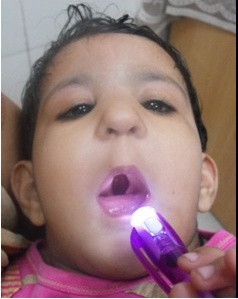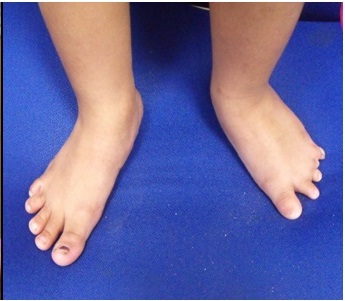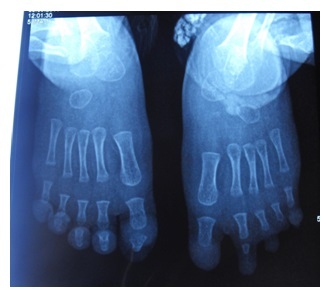Hypoglossia-Hypodactyly Syndrome with Short Stature - A Case Report
Manisha Goyal1, Ankur Singh2, Pratiksha Singh3, Seema Kapoor4
1 Senior Research Officer, Department of Pediatrics, Maulana Azad Medical College Associated Lok Nayak Hospital, New Delhi, India.
2 Senior Research Associate, Department of Pediatrics, Maulana Azad Medical College Associated Lok Nayak Hospital, New Delhi, India.
3 PhD Student, Department of Pediatrics, Maulana Azad Medical College Associated Lok Nayak Hospital, New Delhi, India.
4 Professor, Department of Pediatrics, Maulana Azad Medical College Associated Lok Nayak Hospital, New Delhi, India.
NAME, ADDRESS, E-MAIL ID OF THE CORRESPONDING AUTHOR: Dr. Seema Kapoor, M-439, Ground Floor, Guruharkishan Nagar, Paschim Vihar, New Delhi-110087, India.
Phone: 9968604313,
E-mail: drseemakapoor@gmail.com
The Oromandibular Limb Hypogenesis Syndromes (OLHS) comprises a spectrum of disorders involving the tongue, mandible, and the limbs and are characterized by hypoplastic mandible, absence of the lower incisors, hypoglossia, digits and limbs abnormalities ranges from syndactyly to amelia. In this report, we report a case of OLHS with growth hormone deficiency as a cause of short stature, which has not been described previously to the best of our knowledge.
Case Report
A 3-year-old girl presented to our Outpatient Department (OPD) for evaluation of cleft palate, limb anomaly and lack of weight gain. She was second in birth order, born by vaginal delivery at term to a non- consanguineous couple. Her birth weight was 2.7 kg. Her mother’s antenatal and perinatal histories were uneventful. She had a history of one previous spontaneous abortion. She had an elder brother, who was intelligent, with no facial dysmorphism. She had motor delay; had started sitting without support at 10 months of age and independent walking at 17 months of age. She had normal cognition with poor speech. On physical examination, her head circumference and weight were found to be 45 cm (between-2 and- 3 S.D.) and 10.5 kg (between-2 and -3 S.D.) respectively. Her height was 83 cm (<-3 S.D.) and she had proportionately short stature. Her face revealed prominent metopic suture, mid face hypoplasia, downward slanting palpebral fissure, broad nasal bridge, anterior rotated ears, bulbous nose, smooth philtrum, microstomia and micrognathia. On oral examination, it was seen that lower incisor teeth was not erupted, tongue was small in size and posterior cleft palate was present [Table/Fig-1]. Limb examination showed partial syndactyly of 3rd and 4th fingers of left hand, absent 4th left toe with brachydactyly (short digits) of 3rd and 5th left toes. Toe nails were hypoplastic [Table/Fig-2].
Cleft palate,mid face hypoplasia, downward slanting palpebral fissure, broad nasal bridge, anterior rotated ears, bulbous nose

Absent 4th left toe with brachydactyly of 3rd and 5th left toes

Radiograph which was taken at the age of 17 months showed non-visualization of distal phalanx of 5th right toe, absent distal phalanxes of 1st and 2nd left toes and middle and distal phalanxes of 3rd, 4th and 5th left toes [Table/Fig-3]. Bone age was 1 year, which was less than chronological age. Rest of the skeletal survey was normal. Detailed systemic clinical examinations which were done were normal.

Laboratory investigations showed a normal haemogram, liver function test, renal function test, thyroid profile and urinalysis. Ultrasound of abdomen which was done was normal. Growth hormone stimulation test after clonidine showed 0.5, 2.06, 5.32, 2.82 and 1.65 ng/mL at 0, 30, 60, 90 and 120 minutes respectively. IGF-1 was 18 ng/mL (ref. 20-250 ng/mL for 3-8 years).
Discussion
Hypoglossia-hypodactyly syndrome (OMIM 103300) is a rare syndrome which was classified by Hall as ‘oromandibular and limb hypogenesis syndrome’ (OLHS). OLHS is characterized by a hypoplastic mandible, absence of the lower incisors, hypoglossia, abnormalities of digits and limbs which range from syndactyly to amelia [1]. Diagnosis, in the present case, was based on the following features: midface hypoplasia, micrognathia, absent lower incisor teeth, hypoglossia, cleft palate, brachydactyly and hypodactyly of lower limb, short stature and developmental delay. OLHS represents a range of disorders which affect the tongue and the limbs. Accordingly, this case was OLHS type IIA: hypoglossia-hypodactyly. OLHS was classified by Hall into five types [1]. Type I included hypoglossia and aglossia in isolation. Type II included hypoglossia with hypomelia/ hypodactylia. Type III included glossopalatine ankylosis with hypoglossia or hypoglossia and hypomelia/hypodactyly. Type IV included intraoral bands with fusion with hypoglossia or hypoglossia and hypomelia/hypodactyly. Type V included several syndromes such as Hanhart syndrome, Pierre Robin syndrome, Moebius syndrome, and amniotic band syndrome.
The tongue development begins during the fourth week of gestation on the floor of the pharynx, from portion of 1, 2, 3 and 4th pharyngeal arches. First pharyngeal arch forms the anterior 2/3rd part of tongue [2,3]. The posterior part of the tongue is derived from second, third and fourth pharyngeal arches. Portion of occipital somites migrate to the tongue and form the musculature of the tongue. Limb development begins with the proliferation of lateral part of mesoderm in the cervical region (upper limb) and in the lumbar and sacral regions (lower limb), started at fourth week. As limb buds lengthen, the central mesoderm forms cartilaginous part of limb bones and surrounding mesoderm forms the perichondrium, connective tissue and musculature of the limbs. It has been hypothesized that any insult caused during this period can cause defects in the development of tongue, mandible and limbs, leading to development of OLHS. Although the aetiology of this rare syndrome remains unknown, genetic factors as well as environmental factors have been postulated as the causes [4,5]. Environmental factors include maternal exposure to radiation and teratogenic drugs, trauma and vascular accidents, chorionic villous sampling procedures, and maternal hyperthermia [6–8].
This is an extremely rare condition with as few as 47 cases having been reported in the world literature [9]. Robertson and Bankier described an intellectually normal 20-year-old man with features which resembled those of our case. He had an extreme degree of micrognathia, a very small tongue, right synbrachydactyly of digits 1-2-3, and terminal transverse defects of the wrist on left side and on left knee [10]. Although intelligence is normal in hypoglossia- hypodactyly, Cohen et al., have described a patient with mental retardation [11]. Additional features such as situs inversus, dextrocardia and asplenia have been reported, in addition to the already described features of hypoglossia-hypodactyly syndrome [12]. A recent report has described supernumerary nipples, microcephaly and a micropenis with cryptorchidism as anomalies which were associated with hypoglossia- hypodactyly [13].
In our case, the child had mild developmental delay, short stature, along with a speech difficulty. Presence of a hypoplastic tongue, along with cleft palate, explains the speech difficulty. We had excluded familial and constitutional causes of short stature. A growth Provoked GH stimulation test confirmed the diagnosis of growth hormone deficiency. There is no sufficient data on benefits of growth hormone supplementation in OLHS cases. We had not started GH in our case. Management which is required is multi-disciplinary efforts made by a team of specialists. Training of the reduced tongue is helpful for achieving tongue function, which helps in successfully adapting to increased space in the oral cavity [14]. Speech therapy improves phonetics. An early surgical intervention is desirable in the presence of severe anomalies [15]. Substituting muscles for tongue is indicated only if hypoplasia is severe. Prosthetic limbs can improve the locomotion. An early intervention and proper guidance are more important for improving the quality of life of affected persons. As genetic locus is unknown till date, there is a need for providing multispeciality care for diagnosed cases, for improving the outcome.
[1]. Hall BD, Aglossia-adactyliaBirth Defects Orig Artic Ser 1971 7:233-6. [Google Scholar]
[2]. Larsen William J, Human embryology 2001 EdinburghChurchill Livingstone [Google Scholar]
[3]. Wada T, Inoue K, Fukuda T, Mizokawa N, Tanaka T, Sugai T, Hypoglossia hypodactylia syndrome: report of a caseJ Osaka Univ Dent Sch 1980 20:297-304. [Google Scholar]
[4]. Gorlin RJ, Cohen MM Jr, Hennekam RCM, Syndromes of the Head and Neck 2001 4 editionNew York, NY, USAOxford University Press [Google Scholar]
[5]. Dellagrammaticas H, Tzaki M, Kapiki A, Sianidou L, Philippidis P, Papas C, Hanhart syndrome: possibility of autosomal recessive inheritanceProg Clin Biol Res 1982 104:299-305. [Google Scholar]
[6]. Meundi MA, Nair GR, Sreenivasan P, Raj AC, Oromandibular Limb Hypogenesis Syndrome Type IIB: Case Report of Hypoglossia-HypodactylyCase Rep Dent 2013 2013:370695 [Google Scholar]
[7]. Bökesoy I, Aksüyek C, Deniz E, Oromandibular limb hypogenesis/Hanhart’s syndrome: possible drug influence on the malformationClin. Genet 1983 24:47-9. [Google Scholar]
[8]. Lipson AH, Webster WS, Facial-limb hypogenesis syndromes after chorionic villus samplingLancet 1993 341:759 [Google Scholar]
[9]. Mishima K, Sugahara T, Mori Y, Sakuda M, Case report: hypoglossia-hypodactylia syndromeJ Craniomaxillofac Surg 1996 24:36-9. [Google Scholar]
[10]. Robertson SP, Bankier A, Oromandibular limb hypogenesis complex (Hanhart syndrome): a severe adult phenotypeAm. J. Med. Genet 1999 83:427-9. [Google Scholar]
[11]. Cohen MM Jr, Pantke H, Siris E, Nosologic and genetic consideration in glossy adactyly syndromeBirth Defects Orig Artic Ser. 1971 7:237-40. [Google Scholar]
[12]. Oulis CJ, Thornton JB, Severe congenital hypoglossia and micrognathia with other multiple birth defectsJ Oral Pathol 1982 11:276-82. [Google Scholar]
[13]. Gathwala G, Singh J, Dalal P, Garg A, Hypoglossia-hypodactyly syndrome in a newbornJ Craniomaxillofac Surg 2011 39:99-101. [Google Scholar]
[14]. Yasuda Y, Kitai N, Fujii Y, Murakami S, Takada K, Report of a patient with hypoglossia-hypodactylia syndrome and a review of literatureCleft Palate Craniofac J 2003 40:196-202. [Google Scholar]
[15]. Coskunfirat OK, Velidedeoglu HV, Demir Z, Kurtay A, An unusual case of hypoglossia- hypodactyly syndromeAnn Plast Surg 1999 42:333-6. [Google Scholar]